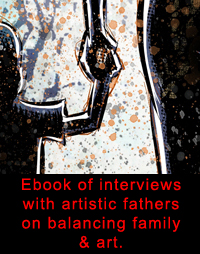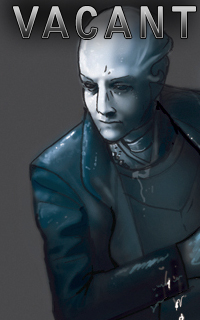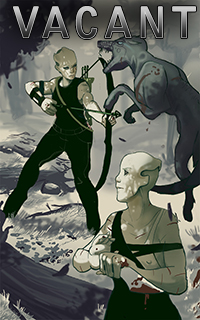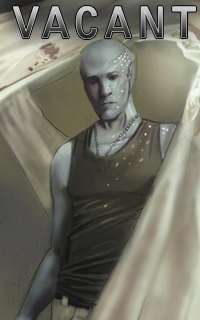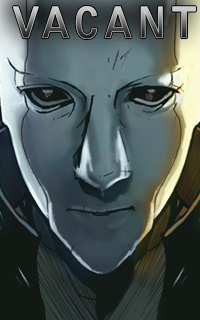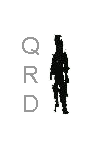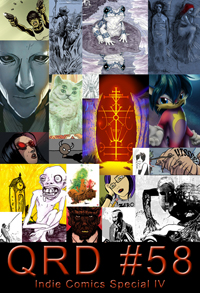
February 2013
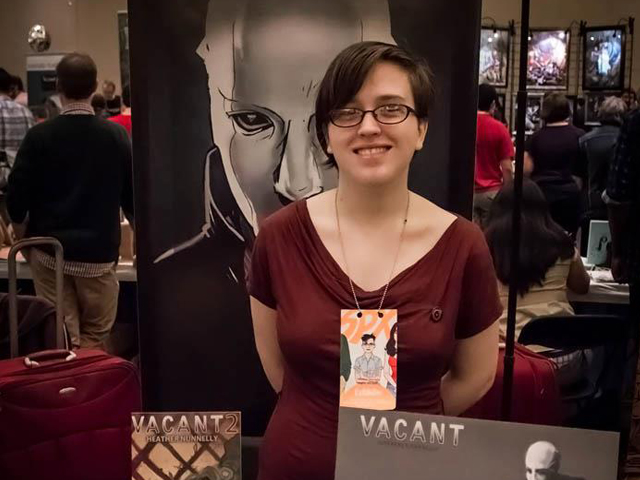
City: New York City
Comics: Before I Sleep, What If, & VACANT
Websites: www.Imaginetheending.net/Vacant.html
QRD – How old were you when you first got into comics & did you always stick with them or did you come back to them?
Heather – I was about 12. My brother let me borrow Shonnen Jump & since then I have been reading them. I started drawing comics in high school.
QRD – What was the first comic book you ever bought?
Heather – Chobits. Which is kind of odd since I was in middle school.
QRD – How old were you when you put out your first comic?
Heather – Before I Sleep was my first comic & I drew that the senior year of high school. So I was about 16-17 years old.
QRD – What decade do you think produced the best comics?
Heather – Hmmmmm. I like comics from all decades, really.
QRD – Why comics instead of just writing or drawing?
Heather – That’s a good question because I never intended to do comics as a career. I studied comics because I thought it would give me a wide variety of skills. Turned out I was pretty good at it, so I kept going. Comics for me bring the best of both worlds together. Comics are very challenging, so it keeps me thinking. On the side, I still write & draw, though. I have been writing since I can remember, & I still draw illustrations from time to time.
QRD – Do you see mini-comics & indie comics as paths to mainstream comics or as their own unique media?
Heather – Depends on how someone would approach this question. If you mean popularity & acceptance, I would say yes. Because of manga & movies, the comic world has expanded. Independent comics are more accessible & are being put on comic shelves.
QRD – How many copies of your comic do you print in your first run?
Heather – Oh god. I am trying to remember. I printed 60 copies of Vacant for the first print run. Any comics I did before that I just printed 20. Usually hard copies didn’t sell well. Then again, I was just a student at the time.
QRD – How much do you think comics should cost?
Heather – I think comics should cost however much it needs to keep the artists alive & healthy. With print costing an arm & a leg to do now-a-days, hard copy comics have been going up in price. Sadly, that’s just how it is for the time being. My issues are $4.00, which is pretty expensive; but I charge that so I have enough to buy more comics.
QRD – How many books do you produce a year & how many would you like to?
Heather – Well, I want to get the VACANT graphic novel done this year; but with as little time as I have, I don’t know if that will happen.
QRD – Do you think stories should be serialized or delivered as complete works?
Heather – Doesn’t matter to me. It all depends on what the artist wants. Some stories work in a series. Some don’t. Walking Dead is a good example of a series that seems to be doing pretty well for itself. My favorite comic is The Killing Joke, & that’s a complete book. No matter, I like stories that have a beginning, middle, & end. If it’s more than 10 volumes, I start to get bored.
QRD – How are comic strips different than comic books & which medium do you prefer?
Heather – Strips are different because they are single page comics that usually execute complete ideas in just a few panels. Typically, they are also used for comedy, but I’ve seen a few serious ones. Comic books (such as issues or graphic novels) are much more varied when it comes to the way they are drawn. I draw both.
Ask My Characters is a strip I draw every Wednesday on my Tumblr, & I enjoy that structure quite a bit because it’s an obstacle I provide for myself. I have to deliver my joke in only three panels. Which is hard to do. However, Vacant is done in the graphic novel layout. I like the latter more because I don’t feel as limited. Also, I like to write serious ongoing stories.
QRD – How long is it from when you start a comic until it’s printed?
Heather – Maybe three to four months. Mainly, because sometimes it takes me that long to draw an issue. I pencil, ink, letter, & color all of it by myself, so it takes me forever.
QRD – What do you do better with your comics now than when you first started?
Heather – Everything. Especially the drawing & pacing. Before I Sleep’s storytelling was fine. It was very easy to read & that carried over to Vacant. So that didn’t change, but I did make the storytelling more economic over time. A lot more was explained in Vacant issue 1 than Before I Sleep. Also, I draw much faster now. Back then it took me a week to draw a page, & the pages were simple. There were no backgrounds or perspective. Vacant has a lot more & I get a page completed in a couple days.
QRD – Do you do thumbnails?
Heather – Yes. My thumbnails look horrible though.
QRD – At what size do you draw?
Heather – 15 by 10 inches. For the strips I just draw them in my sketchbook.
QRD – What kind of pens do you use?
Heather – Jetpens. They are basically brush pens & I love them.
QRD – What does your workstation look like?
Heather – Pretty cluttered. I have my Mac, my pencil box, paper, my little filing cabinet with business cards in it, & trash.
QRD – At what point in the artistic process do you work digitally?
Heather – After I draw the figures. If there is a lot of perspective, the background will be done on the computer.
QRD – What do you think of digital comics & webcomics?
Heather – I don’t really read webcomics. Which is partly why I understand that a lot of people forget to read Vacant. I just get distracted; don’t have time or whatever. Boxerhockey I still keep up with, but all the other ones I’ve been pretty bad about. Usually, I’ll just buy a hard copy version.
QRD – Do you prefer working in color or black & white?
Heather – Mmmmmmmmm….color? I like both, so it’s hard to say. I like color because it adds another layer to the storytelling. I use it to make it easier for the reader to understand what is happening. Especially for Vacant. No one probably notices, but everything is color-coded. For example, if a character has the potential to be on Hayze’s crew, they will wear a black shirt. If they aren’t wearing a black shirt, then they will wear similar pants.
The only scene where that didn’t happen was the scene in which Hayze is fighting with Jin at the end of issue 1. Hayze is wearing all black & Jin was wearing brown & grey. At that point of the story, Jin & Hayze technically aren’t a part of the same team. Jin had temporarily parted ways to spend time with his family. Having no associating color between the two characters creates a wall. They no longer have an association with one another.
I think a lot about this. Ha-ha! I am a little insane, so I will screen cap movies & study color for fun. Very nerdy, I know.
QRD – How many different people should work on a comic & what should their jobs be?
Heather – I don’t really prefer a number. I mean, four people work on Vacant. My assistant writers & I. Sometimes having a lot of people on a piece of work aids the final product & sometimes it doesn’t. Sometimes having too many people teamed together makes the comic very unfocused. It becomes kind of mushy & confusing.
Also, if one person on the team fails, then the whole comic fails. If you have a bad colorist, good luck! Because coloring can destroy anything it touches. Same goes for pencils & inks.
QRD – How do you find collaborators?
Heather – I don’t. It’s just hard to do since collaborators do work for free. Unless someone really likes your writing or drawing, no one does work without pay. Especially since comics take forever. No one has time anymore. My assistant writers work with me because they are my friends & they support me. If I had money, then I would find people to collaborate; but I am poor. Ha-ha.
QRD – How tight do you think a script should be as far as telling the artist what to draw?
Heather – Depends again. Artists should work with whatever they are comfortable with. My scripts are extremely strict. All of my scripts are written like novels & I get pretty anal about how it’s translated into panel-to-panel storytelling. If I wrote for someone, I have a feeling that they would hate me.
QRD – What comic book person would you be most flattered to be compared to?
Heather – Comic book person? Oh, I don’t know. Uhmmm…David Mazzucchelli. Maybe? I don’t know how I’d feel if I got compared to him because David & I are pretty different when it comes to drawing a comic. I am more so influenced by video games & movies. Someone compared me to Usual Suspects & I was very very flattered by this. If anyone compares me to Silent Hill, I do a little bow in my head. Same goes for games like Half Life & Bioshock, even though I don’t think I am anywhere close to the talent that works on the Half Life series.
QRD – What do your friends & family think of your comics?
Heather – My friends like my comics & they support me. My family supports me, but I have no idea if they like them.
QRD – What do you think of superheroes?
Heather – I used to hate them, but then I went to School of Visual Arts & grew to appreciate them for what they are. The Killing Joke, like I said earlier, is one of my favorite comic books.
QRD – Marvel or DC?
Heather – DC. I just like the characters in that universe more.
QRD – What comic characters other than your own would you like to work with?
Heather – Oh man. I don’t know. No comic characters. I would like to write video game ones. I would say Silent Hill, but I don’t want to ruin that franchise more than it has already been ruined. I would love to write for Uncharted. All of those characters are very likable & I enjoy the campiness of the game.
QRD – Ideally would you self-publish?
Heather – I already am self-published. Ideally, I don’t know if it’s my best option just because it is so hard to do. There is so much work that goes into it that it’s rough. Maybe if I somehow become very rich it would be more appealing. Then I could hire someone to do advertising.
QRD – What conventions do you try to attend & why?
Heather – SPX: My second favorite con. It’s small & friendly. You don’t have to jump over people or be trampled to death. TCAF: Loads of talent goes to this & I can sit by Ross Campbell’s desk & chill out with him. & eat crepes. MoCCa: Very expensive, but I like the crowd. Very friendly & leans more to self-published work.
QRD – What do you do to promote your books?
Heather – I advertise on The Webcomic List, Deviantart, Smackjeeves, & all these other social sites.
QRD – Do you think your comics are well suited to comic shops or would sell better elsewhere?
Heather – I thought that they would fail in comic shops, but they actually do pretty well. On the internet I have a hard time. Much harder than Before I Sleep.
QRD – What other medium would you like to see some of your comics made into (television, film, games, action figures, etc.)?
Heather – Video games, film, & action figures. That’s just awesome to me. I would like to be like Walking Dead. Just VACANT crap everywhere.
QRD – Do you consider yourself a comic collector or a comic reader or both?
Heather – Comic reader. I own a lot of comics, but not nearly as much as others.
QRD – What do you see as the most viable mediums for comics distribution 10 years from now?
Heather – The internet. It seems to be going in that route.
QRD – What would you like to see more people doing with comics?
Heather – Make good comics. Like passionate, inspired comics that try to change the world. Well, not change the world, but make the world significantly cooler than what it was before. A lot of the comics I read feel very similar to one another. As though everyone is trying to be published & accepted by a company with a niche. Artists focus on what others want, or they try too hard to be the next Robert Crumb, Stan Lee, Jack Kirby, & so forth. Do your thing & take risks. Don’t walk in shallow water. Just jump.
You may fall. You may fail, but you have to try. If you like your work & you think it’s awesome, someone else will too. Think about it the same way you organize a party. Organize a party you’d have a blast at & the people who attend will share the same enthusiasm. If you smile, they smile.
Sounds cheesy, but it is the only reason why VACANT was made. At several instances I thought for sure this comic would bomb. Odds were against me, but I did it anyway. My characters are awesome to me & I feel like that is communicated to everyone else. VACANT is about a blue dude & a purple dude that looks like a cat. On paper that sounds terrible, but I have people who love them.
Insecurity also shows. I have a horrible self-esteem regardless of how much I love Hayze & Jin & that is very apparent. A publisher told me I needed to gain confidence. That’s probably the only thing that hinders the comic. Artists can tell that I don’t believe in myself. I allow other opinions to affect what I do.
Artists will always have self-doubt, but don’t be like me. Draw what YOU love & give the middle finger to anyone who objects. Success doesn’t matter. YOU matter. What you have to say matters.
QRD – Anything else?
Heather – Thanks for asking me these questions!! Much appreciated.






